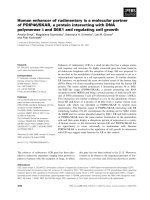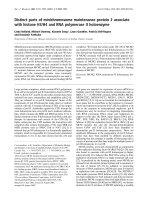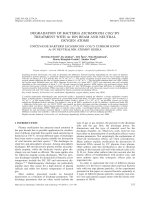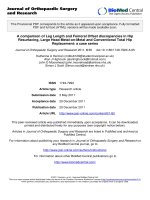Investigations of carbon nanotube based electronic devices with focus on metal and carbon nanotube contacts
Bạn đang xem bản rút gọn của tài liệu. Xem và tải ngay bản đầy đủ của tài liệu tại đây (3.75 MB, 220 trang )
INVESTIGATIONS OF CARBON NANOTUBE BASED
ELECTRONIC DEVICES WITH FOCUS ON METAL
AND CARBON NANOTUBE CONTACTS
HUANG LEIHUA
NATIONAL UNIVERSITY OF SINGAPORE
2011
INVESTIGATIONS OF CARBON NANOTUBE BASED
ELECTRONIC DEVICES WITH FOCUS ON METAL
AND CARBON NANOTUBE CONTACTS
HUANG LEIHUA
(B. Sci. (Hons.), Fudan University)
A THESIS SUBMITTED
FOR THE DEGREE OF DOCTOR OF PHILOSOPHY
DEPARTMENT OF ELECTRICAL AND COMPUTER
ENGINEERING
NATIONAL UNIVERSITY OF SINGAPORE
2011
i
ACKNOWLEDGMENTS
Many individuals deserved to be appreciated for their contributions and
support to the completion of the work within this dissertation.
First and foremost, I would like to express my deep gratefulness to my
thesis advisor, Prof. Chor Eng Fong who made the whole work possible. My
experience of working as a student of Prof. Chor is an invaluable treasure, which
will benefit my whole life. Her experience, knowledge and side by side guidance
have been invaluable throughout my graduate career. I feel lucky to have her as
mentor, and will always cherish these years being a student of hers.
I would also like to express my appreciation to my co-supervisor Prof. Wu
Yihong for providing insightful suggestions and devoting a lot of his precious
time to my work. He creates every opportunity to help me to connect, learn, and
benefit from other researchers in the field. I have been truly benefited from his
valuable opinions, encouragement, and the collaboration with his lab.
I am also deeply indebted to my co-supervisor Dr. Guo Zaibing in Data
Storage Institute (DSI) for extensive discussions for my work and creating a lot of
opportunities for me to use the equipments of DSI which is extremely helpful to
my research work. I have learned much knowledge and skills about process and
ii
characterization of semiconductors from Dr. Guo, which leads me to a better
understanding on my own and other people‘s research work.
I would also especially like to thank Ms. Musni bte Hussain and Mr. Tan
Beng Hwee who have provided me a joyful working environment and much great
help in centre for optoelectronics (COE). My gratitude also goes to Mr Loh Suan
Bin who was an undergraduate in Prof Chor‘s group. He helped optimize the
dispersion process of carbon nanotube solution which has been a great help on my
dissertation projects.
Finally I want to thank my parents for their unconditional love and always
standing by me and my wife, Dr. Li yanfeng, for her enormous sacrifice to
support my work.
iii
Table of Contents
Page
ACKNOWLEDGEMENT i
TABLE OF CONTENTS iii
SUMMARY ix
LIST OF TABLES xii
LIST OF FIGURES xiii
LIST OF SYMBOYS xx
LIST OF ABBREVIATIONS xxii
CHAPTER
1 INTRODUCTION 1
1.1 The transport characteristic of single wall carbon nanotube 2
1.2 Carbon nanotube and metal contact 4
1.2.1 Atomic structure of carbon nanotube and metal contacts 4
1.2.1.1 Carbon nanotube and metal contact with side-contact structure 6
1.2.1.2 Carbon nanotube and metal contact with end-contact structure 7
1.2.1.3 Summary of the atomic structure of carbon nanotube and metal
contacts 8
1.2.2 Charge transfer between metals and carbon nanotube contacts 9
1.3 Carbon Nanotube based devices 12
1.3.1 Carbon nanotube field effect transistors (CNTFET) 13
iv
1.3.1.1 p-type carbon nanotube field effect transistors 13
1.3.1.2 Ambipolar carbon nanotube field effect transistors 16
1.3.1.3 n-type carbon nanotube field effect transistors 17
1.3.1.4 The challenges of CNTFET 19
1.3.2 Carbon nanotube diodes 22
1.4 Motivation and Synopsis of Thesis 24
1.4.1 Ohmic metal carbide and SWCNT contacts 26
1.4.2 Random network carbon nanotube transistor 27
1.4.3 Schottky carbon nanotube diodes by contact engineering 30
1.4.4 Double-Wall carbon nanotube field effect transistors 31
1.5 Outline of thesis 33
2 EXPERIMENTAL PROCEDURE FOR THE FABRICATION AND
CHARACTERIZATION OF CARBON NANOTUBE BASED DEVICES 35
2.1 Preparation of carbon nanotube solution for device fabrication 35
2.1.1 Dispersion of carbon nanotubes 35
2.1.2 Purification of carbon nanotube solutions 40
2.2 Fabrication procedure of individual single wall carbon nanotube field effect
transistor 42
2.2.1 Alignment of carbon nanotubes 42
2.2.1.1 Floating potential AC dielectrophoresis 42
v
2.2.1.2 Large scale AC dielectrophoresis 49
2.2.2 The formation of metal and carbon nanotube contacts 51
2.2.3 Removal of metallic carbon nanotubes 54
2.3 characterization of carbon nanotube based devices 59
2.3.1 Morphological characterization of carbon nanotube devices 59
2.3.2 Electrical characterization of carbon nanotube devices 61
2.4 Summary 62
3 HIGH PERFORMANCE CNTFET WITH NIOBIUM CARBIDE CONTACT
64
3.1 Advantages of metal carbides 64
3.2 The formation of niobium carbide at SWCNT and Niobium contacts 66
3.3 XRD characterization of niobium carbides 69
3.4 Electrical properties of niobium carbide in CNTFET 72
3.5 Comparison of niobium carbide contacts with titanium carbide and
palladium contacts 81
3.6 summary 86
4 n-TYPE RANDOM NETWORK SINGLE-WALL CARBON NANOTUBE
FIELD EFFECT TRANSISTOR WITH YTTRIUM CONTACTS 88
4.1 The advantages of carbon nanotube thin film transistors 88
vi
4.2 The status of n-type rn-SWCNT FET 89
4.3 Fabrication procedure of Yttrium contacted rn-SWCNT FET 91
4.4 The electrical characterization of rn-SWCNT FET with Yttrium contacts
93
4.5 Optimization of rn-SWCNT FET by chemical etching 102
4.6 Summary 110
5 THE SEMICONDUCTING-SEMICONDUCTING DOUBLE WALL
CARBON NANOTUBE FIELD EFFECT TRANSISTORS 112
5.1 The unique electrical properties of double wall carbon nanotube 112
5.2 The Status of DWCNT FET 113
5.3 The fabrication procedure of DWCNT FET 114
5.4 The electrical characteristics of DWCNT FET 116
5.4.1 The relationship between DWCNT FET characteristics and the structure
of DWCNT 116
5.4.2 Comparison between s-s DWCNT FET and s-SWCNT FET 118
5.4.2.1 For large diameter nanotubes (d 2 nm) 120
5.4.2.2 For intermediate diameter nanotubes (2 > d 1.6 nm) 126
5.4.2.3 For small diameter nanotubes (d < 1.6 nm) 128
5.5 The Ruthenium contacted DWCNT FET 130
5.6 Summary 133
vii
6 FABRICATION OF SINGLE-WALL CARBON NANOTUBE SCHOTTKY
DIODE WITH ASYMMETRIC THIOLATE MOLECULES MODIFIED GOLD
CONTACTS 135
6.1 Carbon nanotube Schottky diodes 135
6.2 The fabrication procedure of SWCNT Schottky diodes with thiolate
molecules 139
6.3 The electrical characteristic of the SWCNT Schottky diodes 142
6.3.1 The modification effect of thiolate molecules on the SWCNT and Au
contacts 142
6.3.2 The working mechanism of the SWCNT Schottky diodes 149
6.3.3 Enhancing SWCNT Schottky diode performance using asymmetric
thiolate molecules modified gold contacts 154
6.3.4 The effect of back gate voltage on the electrical characteristic of the
SWCNT Schottky diodes 157
6.3.5 The stability of SWCNT Schottky diodes by thiolate molecules 159
6.4 Summary 161
7 CONCLUSIONS AND SUGGESTED FUTURE WORK 162
7.1 Conclusion 162
7.1.1 High performance CNTFET with niobium carbide contact 162
viii
7.1.2 n-type random network single-wall carbon nanotube field effect
transistor with Yttrium contacts 163
7.1.3 Fabrication of single-wall carbon nanotube Schottky diode with gold
contacts modified by asymmetric thiolate molecules 164
7.1.4 Semiconducting-semiconducting double-wall carbon nanotube field
effect transistors 165
7.2 Suggested future work on carbon nanotube electronics 167
7.2.1 Other metal carbide contacts for CNTFET application 167
7.2.2 Metal gate engineering 168
7.2.3 Graphene FETs 169
7.2.3.1 Brief comparison between graphene and CNT 169
7.2.3.2 Comparison between graphene FET and CNTFET 170
7.2.3.3 Future work on graphene and metal contact 172
Reference 174
List of publications 195
ix
Summary
Carbon nanotube field effect transistors (CNTFETs) have attracted much
attention owing to their potential importance to integrated circuits. However, to
date, there are still challenges faced by CNTFET, e.g., the optimization of Ohmic
contacts between CNT and metal, the precise position and alignment of CNT, and
the presence of both metallic and semiconducting CNTs during synthesis and the
inability to remove all the metallic CNTs during subsequent device fabrication.
In our work, we have developed a thermal solid state reaction method to
achieve niobium carbide (Nb
2
C) between single wall CNT (SWCNT) and
niobium (Nb) electrodes. It is found that the Nb
2
C contact exhibits very small
Schottky barrier (~18meV) to p-type transport which means near Ohmic contact
to SWCNT has been achieved. More importantly, the Schottky barrier between
SWCNT and Nb
2
C contact is almost independent of the tube diameter (d) for d
down to 1 nm. The performance of Nb
2
C contacted SWCNT FET is as good as
that with Pd contacts for d > 1.6 nm and better when d is smaller than 1.6 nm. In
addition, Nb
2
C contact surpasses titanium carbide (TiC) contacts by yielding
more unipolar FET characteristic.
In order to overcome the challenges of alignment and positioning issues of
CNT and of removing metallic CNTs in device fabrication, we have also
developed thin film FET based on random network of SWCNT. Owing to the lack
of study on n-type random network SWCNT FETs (rn-SWCNT FETs), we focus
x
on their fabrication by means of contact engineering, using low work function
metal Yttrium. As expected, the rn-SWCNT FETs have better reproducibility than
FETs based on individual SWCNT. By employing 2,4,6-triphenylpyrylium
tetrafluoroborate (2,4,6-TPPT) to selectively etch the metallic nanotubes in the rn-
SWCNT, the FETs achieve high on/off current ratio up to ~10
5
, good unipolar
characteristic with n-/p-branch current ratio ~10
3
-10
4
, high mobility ~25 cm
2
v
-1
s
-1
,
and transconductance ~0.12 S/m. Moreover, they have demonstrated air-stable
n-type characteristics.
We have also demonstrated that SWCNT Schottky diodes can be
fabricated by asymmetrically modifying the Schottky barrier at the two
Au/SWCNT contacts. In our work, thiolate molecules methanethiol (CH
3
SH) and
trifluoroethanethiol (CF
3
CH
2
SH) are used to achieve such modification and the
characterizations have revealed that the highly asymmetrical contacts with
Schottky barrier heights of ~190 and ~40 meV, respectively, can be achieved for
the modified Au/SWCNT contacts. The SWCNT Schottky diodes exhibit good
performance: forward and reverse current ratio higher than 10
4
, forward current as
high as ~5 A, reverse leakage current as low as ~100 pA, and current ideality
factor as low as ~1.42. This is at least comparable to SWCNT Schottky diodes
fabricated with asymmetrical metals which have been well developed.
In addition to the study on CNT and metal contacts, we have investigated
the transport characteristics of double wall carbon nanotube with both
xi
semiconducting tubes (s-s DWCNT). It has been found that the tube-tube
interaction in s-s DWCNT is important to the transport characteristic of DWCNT
and is dependent on the diameter of DWCNT. Hence, the s-s DWCNT FET can
behave differently from SWCNT FET as a result of the variation of the inter-tube
interactions. In general, the conductance of s-s DWCNT is found to be larger than
that of SWCNT with the same diameter, owing to the weaker electron–phonon
scattering in the DWCNT than that in SWCNT as a result of inter-tube interaction.
However, when the tube diameter is very small (<1.6 nm), the bandgap of s-s
DWCNT is greatly reduced owing to the π-σ rehybridization of the even smaller
inner tube. Therefore, it is suggested that DWCNT FET can be one promising
candidate of CNT based devices in addition to SWCNT FET. In the study of
DWCNT FETs, it has also been found that ruthenium oxide (RuO
2
) can form
near-Ohmic contact with DWCNT owing to its high work function and good
wetting properties with DWCNT.
xii
List of tables
Table 1.1 CNFET Technology Challenges and Outlook
Table 2.1: Suppliers and parameters of CNT (SWCNT & DWCNT) samples used
in our experiments.
xiii
List of Figures
Fig. 1.1: Two types of interface between a metal crystal and a carbon nanotube:
end-contact (top) and side-contact (bottom).
Fig. 1.2: Schematic of a back-gated SWCNT FET
Fig. 1.3: Band structure diagram of a p-type SB-CNTFET. (a) With no bias on the
gate, a large Schottky barrier exists between the valence band of the
CNT and the Fermi level (Ef) of the source contact. A positive bias on
the source lowers the Fermi level of the source and raises the level of
the drain. (b) A negative bias on the gate raises the conduction and
valence band of the CNT. The shift in bands leads to a narrower
Schottky barrier at the source/CNT interface and allows holes to be
transported from the source to the valence band of the CNT.
Fig. 1.4: Schematics of a rn-SWCNT FET.
Fig. 2.1: Dispersed CNT solution by NaDDBS (~ 0.1 M), after homogenization
for 20 minutes (left), and after 2 weeks on storage (right).
Fig. 2.2: (a) Schematic diagram of the centrifugation process for removal of
impurities in the CNT solution. (b) The CNT solution before and after
the centrifugation process.
Fig. 2.3: Schematic of AC dielectrophoresis setups: normal AC dielectrophoresis
(top figure) and floating potential AC dielectrophoresis (bottom figure),
which has additional floating electrode compared to the normal AC
dielectrophoresis.
Fig. 2.4: (a) The schematic layout of floating-potential AC dielectrophoresis (FPD)
- region I is the controlled region and region II is the floating region.
The arrows in the figure indicate the distribution of electric field in
these regions. (b) Schematic layout of wafer scale floating- potential
xiv
AC dielectrophoresis, and the experiment setup (top view): one probe is
put on the biased electrode (BE) and another probe on the substrate of
the probe station (GE).
Fig. 2.5: SEM pictures showing the results of floating potential dielectrophoresis:
(a) the controlled region (I), where both SWCNT bundles and
amorphous carbons are attracted to the electrodes, and (b) the floating
region (II), where only one individual SWCNT is aligned across the
electrodes.
Fig. 2.6: SEM picture of device based on individual SWCNT fabricated by wafer
scale AC dielectrophoresis. The arrow indicate the positon of the
SWCNT.
Fig. 2.7: Fabrication process of CNTFETs with CNTs lying on top of metal
electrodes: (a) high doping n-type silicon substrate is used as the back
gate, (b) SiO
2
is grown as the gate insulator by means of thermal
oxidation, (c) resist is spin-coated onto the surface of substrate, (d)
lithography is carried out to define the shape and position of the metal
electrodes, (e) exposed resist is removed by the appropriate developer,
(f) metals are deposited by electron beam evaporation, g) metal lift-off
is performed with the help of ultra-sonicator, h) CNTs in the solution
are deposited onto the top surface of metal electrodes, and the
fabricated devices are cleaned by rinsing in DI water and dried by
nitrogen gas.
Fig. 2.8: the I
DS
-V
GS
curves of a CNTFET with a bundle of SWCNTs as the
channel, before and after the electrical breakdown process (V
DS
= 8 V
and V
GS
= 10 V).
Fig. 2.9: I
DS
-V
GS
curves of a CNTFET whose channel has both metallic and
semiconducting SWCNTs, before and after the chemical etching
process using 2,4,6-TPPT molecules (V
DS
= 0.1 V).
Fig. 2.10: Electrical measurement setups for (a) CNTFET, and (b) CNT diode.
xv
Fig. 3.1: SEM picture of a typical Nb contacted SWCNT FET, the alignment of
one individual SWCNT between two Nb electrodes is achieved by
using AC dielectrophoresis with applied AC voltage V
P-P
~ 8 V,
frequency f ~ 1 MHz and duration time t ~ 1 minutes.
Fig. 3.2: SEM pictures of a typical Nb and SWCNT contact: (a) before, and (b)
after annealing in vacuum at 700
o
C for 1 hr (resulted in the formation
of niobium carbide, Nb
2
C). The SWCNT lying on the Nb electrode
becomes invisible after the formation of Nb
2
C, signifying that the
SWCNT has embedded into the electrode.
Fig. 3.3: XRD spectra of SWCNT thin film deposited on 50 nm Nb layer: (a)
before annealing. (b) after vacuum annealing at 700 °C for 1 hr
(resulted in Nb
2
C formation), and (c) after vacuum annealing at 900 °C
for 1 hr (resulted in additional NbC formation). The spectrum after
annealing at 400
o
C is similar to that without annealing.
Fig. 3.4: (a) I
DS
-V
GS
curves (V
DS
= 0.1 V) for the SWCNT FET with Nb contacts
before and after vacuum annealing at 400, 700, 900
o
C for 1 hr. (b)
Corresponding I
DS
-V
DS
curves of the SWCNT FET at V
GS
= 0 V and the
inset is an expanded curve of the SWCNT FET after vacuum annealing
at 400
o
C for 1 hr. The diameter of the SWCNT in the CNTFET is ~
1.5 nm.
Fig. 3.5: Plots of (a) ln(I/T
2
) versus 1/T from 200 to 300 K for different bias
voltages, V = 0.1 to 0.5 V in steps of 0.1 V, to determine the contact
effective Schottky barrier height (
e
) for hole transport, gate bias
V
GS
=0V, and (b) effective SBH as a function of the square root of bias
voltage (
2/1
V
). Schottky barriers at zero bias voltage (
b
) are attracted
for devices after annealing at 400, 700 and 900
o
C, respectively.
Fig. 3.6: I
DS
-V
GS
curves (V
DS
= 0.1 V) of Nb
2
C contacted SWCNT FET
immediately after the formation of Nb
2
C and after exposure to air for
10 days
xvi
Fig. 3.7: I
DS
-V
GS
curves (V
DS
= 0.1V) for Nb
2
C, TiC and Pd contacted SWCNT
FETs (SWCNT diameter ~1.5 nm). Inset shows the corresponding I
DS
-
V
DS
curves (V
GS
= 0 V).
Fig. 3.8: I
DS
-V
DS
curves (V
GS
= 0 V) for (a) Pd contacted SWCNT FETs with 1.53
and 1 nm SWCNTs, and (b) Nb
2
C contacted SWCNT FETs with 1.6
and 1 nm. Insets show the I
DS
-V
GS
curves (V
DS
= 0.1 V) for SWCNT
FETs.
Fig. 4.1: SEM picture of random network of SWCNTs on the SiO
2
substrate.
Fig 4.2: (a) SEM picture of a RN-SWCNT FET with Yttrium source and drain
contacts (the lighter shade regions in figure), and (b) radial breathing
mode Raman characteristic of the RN-SWCNT on the SiO
2
substrate.
Fig. 4.3: IV characteristics of a rn-SWCNT FET (channel length, L
C
= 4 m;
channel width, W
C
= 10 m): (a) I
DS
-V
GS
curve at V
DS
= 0.1 V in linear
scale for V
GS
from -10 to 10 V, and the inset shows the curve in semi
logarithmic scale; and (b) I
DS
-V
DS
curves at V
GS
= 10, 5, and -5 V for
V
DS
From 0 to 1 V.
Fig. 4.4: The effects of rn-SWCNT FET channel length on transistor
characteristics: (a) n-branch On-current (I
ON
), (b) Off-current (I
OFF
), (c)
p-branch on-current (I
p
), (d) on/off current ratio (I
ON
/I
OFF
) and (e) n-/p-
branch current ratio (I
ON
/I
p
). The channel width, W
C
= 10 m and the
data indicated are averages of 20 devices.
Fig. 4.5: Schematics showing the 4 simplified types (I, II, III, IV) of transport
routes in the RN-SWCNT FET channel. An example of combination
transport route (Type II-IV) is also shown.
xvii
Fig. 4.6: (a) I
DS
-V
GS
curves (V
DS
= 0.1 V) of Y contacted rn-SWCNT FET (L
C
= 4
m, W = 10 m) before and after the reaction with 2,4,6-TPPT, (b) I
DS
-
V
GS
curves (V
DS
= 0.1 V) of 20 RN-SWCNT FETs (L
C
= 4 m, W = 10
m) after reaction with 2,4,6-TPPT, demonstrating the small deviation
in the On-current of RN-SWCNT FETs, and (c) the effect of reaction
time on the I
DS
-V
GS
curve of Y contacted rn-SWCNT FET (L
C
= 2 m,
W = 10 m).
Fig. 4.7: The effects of chemical etching by 2,4,6-TPPT on the distribution of (a)
on/off current ratio (I
ON
/I
OFF
), and (b) n-/p-branch on-current ratio
(I
ON
/I
p
) of rn-SWCNT FETs (L
C
= 4 m, W = 10 m).
Fig. 4.8: I
DS
-V
GS
(V
DS
= 0.1 V) curves of a rn-SWCNT FET (L
C
= 4 m, W = 10
m and after reaction with 2,4,6-TPPT, ) with Y/Au (50/30 nm)
electrodes, immediately after fabrication, and after 1 day and 7 days
exposure to air.
Fig. 5.1: (a) Schematic layout of a back-gated carbon nanotube FET, where the
carbon nanotube was deposited on the top of Ti/Au electrodes by AC
dielectrophoresis, and (b) SEM picture of a typical DWCNT FET, (c)
TEM picture of DWCNTs.
Fig. 5.2: (a) I
DS
-V
GS
curves of three types of DWCNT-FETs: metallic (m-m/m-s),
semi-metallic (s-m) and semiconducting (s-s) characteristics. The
diameter of the DWCNTs exhibiting metallic, semi-metallic and
semiconducting characteristics are 2.4, 2.37 and 2.34 nm, respectively.
(b) I
DS
-V
GS
curves of two types of SWCNT-FETs: semiconducting (s)
and metallic (m). The diameter of the SWCNTs exhibiting metallic and
semiconducting characteristics are 1.96 and 2 nm, respectively.
Fig. 5.3: The I
DS
-V
GS
(V
DS
= 0.1 V) comparison between DWCNT and SWCNT
FETs. The diameters of DWCNT and SWCNT are respectively: a) 2.34
and 2.31 nm, b) 1.62 and 1.6 nm, and c) 1.38 and 1.34 nm.
xviii
Fig. 5.4: The On-current (I
ON
) and Off-current (I
OFF
) of DWCNT and SWCNT
FETs as a function of the nanotube diameter. I
ON
is I
DS
at V
GS
= -10 V
and V
DS
= 0.1 V, while I
OFF
is the lowest I
DS
in the range of V
GS
from -
10 to 10 V. the solid red lines are the polynomial fitted curves and the
symbols are the experimental data.
Fig. 5.5: (a) Plots of ln(I/T
2
) versus 1/T for T from 200 to 300 K for different bias
voltages (V = 0.1 to 0.5 V in steps of 0.1 V) for DWCNT and Au
Schottky contact, V
GS
=0V. The biased dependent SBH (Φ
e
) is extracted
and plotted in (b) as a function of bias voltage (V
1/2
) to yield the
Schottky barrier height at zero bias voltage: Φ
b
. The data for SWCNT
and Au Schottky contact are also shown in (b).
Fig. 5.6: Effect of the drain field on the I
DS
-V
GS
characteristics of DWCNT FET
and SWCNT FETs, V
DS
= 0.1 V, 1 V and 3 V.
Fig. 5.7: The I
DS
-V
GS
(V
DS
= 10 mV) characteristics of Ru contacted DWNT FETs
annealed in vacuum or O
2
ambient at 400
◦
C for 15 mins, in comparison
with that of transistor without annealing, the diameter of DWCNT is
about 2.5 nm.
Fig. 6.1: Fabrication of SWCNT Schottky diodes by asymmetrically tuning the
Fermi level lineup at the two Au/SWCNT contacts using different
thiolate molecules: (a) methanethiol (CH
3
SH) and (b)
trifluoroethanethiol (CF
3
CH
2
SH). The Au/SWCNT contact structure
and the dipole direction (indicated by arrows) formed between Au and
the absorbed self-assembled thiolate molecules are shown in (c) for
CH
3
SH and (d) for CF
3
CH
2
SH.
Fig. 6.2: I
DS
-V
GS
curves (V
DS
= 0.1 V) for back-gated SWCNT FETs as a function
of modification duration by (a) methanethiol (CH
3
SH) and (b)
trifluoroethanethiol (CF
3
CH
2
SH).
xix
Fig. 6.3: I-V curves of Au-SWCNT-Au structures before and after modification
by different thiolate molecules: methanethiol (CH
3
SH) and
trifluoroethanethiol (CF
3
CH
2
SH) in (a) linear scale; (b) semi-log scale.
Fig. 6.4: I
DS
-V
GS
curves (V
DS
= 0.1 V) for SWCNT FETs with only SWCNT
channels modified by thiolate molecules and SWCNT/Au contacts are
protected by resist: (a) by CH
3
SH; (b) by CF
3
CH
2
SH.
Fig. 6.5: Energy band diagrams of Au-SWCNT-Au structure under forward and
reverse bias: (a), (b) before modification; (c), (d) after modification by
thiolate molecules, CH
3
SH and CF
3
CH
2
SH. In the Figure, solid arrow
indicates thermionic emission current and dashed arrow indicates
tunneling current.
Fig. 6.6: (a) Plots of ln (I/T
2
) versus 1/T for T from 200 to 300 K for different bias
voltages (V = 0.1 to 0.5 V in steps of 0.1 V) for SWCNT and Au
Schottky contact, V
GS
=0V. The biased dependent SBH (
e
) is extracted
and plotted in (b) as a function of bias voltage (
2/1
V
) to yield the
Schottky barrier height at zero bias voltage: Φ
b
.
Figure 6.7: I-V characteristics of SWCNT Schottky diode at different gate
voltages (V
GS
= -10, 0 and 10 V) in semi-log scale.
Figure 6.8: I-V curves of SWCNT Schottky diode fabricated by SAM technology
after fabrication and after 5 days of exposure to air.
xx
List of Symbols
A Ampere
Al Aluminum
Ag Silver
Au Gold
C capacitance
Ca Calcium
cm centimeter
Co Cobalt
Cr Chromium
d diameter of carbon nanotube
e elementary charge
E
Electric field
E
g
energy bandgap
F
Coulombic force
f frequency
f
T
cut-off frequency
Fe Iron
Gd Gadolinium
g
m
transconductance
h Planck‘s constant
Hf Hafnium
Hz hertz
I
DS
source-drain current
I
forward
forward current
I
reverse
reverse current
I
n
n-branch On-current
I
p
p-branch On-current
I
s
reverse saturation current
I
OFF
off current
I
ON
on current
k Boltzmann‘s constant
L liter
L
C
channel length
m- metallic
Mg Magnesium
Mn Manganese
m micron-meter
xxi
Mo Molybdenum
n current ideality factor
N
2
Nitrogen
Nb Niobium
Ni Nickel
nm nano-meter
O
2
Oxygen
P
dipole moment
Pd Palladium
Pt Platinum
q Electronic charge
R
S
lumped series resistance
Rh Rhodium
Ru Ruthenium
s seconds
S Siemens
s- semiconducting
Sc Scandium
Si Silicon
T time
T
ox
oxide thickness
Ti Titanium
V Volts
V
TH
threshold voltage
V
DS
source-drain voltage
V
GS
gate-source voltage
W Tungsten
W
C
channel width
Y Yttrium
Zr Zirconium
0
Permittivity of free space
SiO2
Permittivity of SiO
2
m
metal work function
b
Schottky barrier height at zero bias
e
Schottky barrier height for electrons
h
Schottky barrier height for holes
Ω Ohm
xxii
List of abbreviations
1D one dimensional
2D two dimensional
3D three dimensional
2,4,6-TPPT 2,4,6-triphenylpyrylium
tetrafluoroborate
AC alternating current
AFM atomic force microscopy
BE biased electrode
CE counter electrode
CF
3
CH
2
SH trifluoroethanethiol
CH
3
SH methanethiol
CMOS Complementary metal–oxide–
semiconductor
CNT carbon nanotube
CNTFET carbon nanotube field effect
transistor
CVD chemical vapor deposition
CCVD catalytic chemical vapor deposition
DC direct current
dec decade
DOS density of states
DWCNT double wall carbon nanotube
EBL electron beam lithography
Fe
3
C Iron carbide
FPD floating-potential AC
dielectrophoresis
GE gate electrode
GFET graphene field effect transistor
GNR graphene nanoribbon
H
2
SO
4
Sulfuric acid
hr hour
HSCH
2
CH
2
NH 2-aminoethanethiol
i-SWCNT individual single wall carbon
nanotube
NaDDBS sodium dodecylbenzene sulfonate
Nb
2
C niobium carbide
PEI Polyethyleneimine
RBM radial breathing mode
rf radio frequency
xxiii
rn-SWCNT random network single wall
carbon nanotube
rpm round per minute
RuO
2
ruthenium oxide
SAM self-assembled monolayers
SB Schottky barrier
SBFET Schottky barrier field effect
transistor
SBH Schottky barrier height
SEM Scanning Electron Microscope
Si
3
N
4
silicon nitride
SiO
2
silicon dioxide
SWCNT single wall carbon nanotube
TEM transmission electron microscopy
TFT thin film transistor
TiC titanium carbide
VLSI Very-large-scale integration
XRD X-ray diffraction









